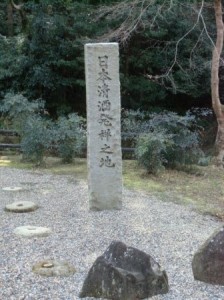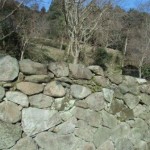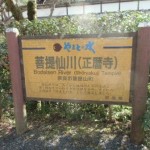 I have long known that Nara Prefecture, which borders Osaka and Kyoto in western Japan, has been known as the birthplace of sake. But I got majorly schooled during a recent visit there.
I have long known that Nara Prefecture, which borders Osaka and Kyoto in western Japan, has been known as the birthplace of sake. But I got majorly schooled during a recent visit there.
Nara, in fact, holds major significance in Japan’s history, and was even the capital from 710 to 784. During that time, there was a brewing department within the walls of the imperial palace in Nara. Sake back then, however, was a far cry from what we enjoy today (for one, it had much less alcohol), and the “Imperial Brewing Department” (the “IBD”?) focused its efforts for the most part on sake used in ceremonies and events. In fact, the IBD produced upwards of a dozen different types of sake, some colored with ash of black, red or white hues, with varying degrees of alcohol content, mostly for use in ceremonies.
Let us first look at a bit more of the history of sake in Nara. In time, like a few hundred years (things moved much more slowly back then) sake-brewing moved into the many Buddhist temples of the Nara region, as they had brought back their initial brewing technology back from China on their, um, supposedly religious expeditions to that mainland.
At this particular juncture of Japanese history (Heian era into Kamakura era, 9th to 13th centuries, roughly), there was a bit of a lull in political and military power, as it moved from the Fujiwara clan to the dueling Taira and Minamoto (Heike and Genji) clans. So there was a bit of a vacuum, or at least a low pressure zone, for a while. The resident monks of the numerous temples, in order to protect both themselves and their interests, militarized a bit. They trained and mobilized themselves, and undertook economic activities as well, including some sake brewing.
 As time passed, they took sides out of necessity, and as power went back and forth, this means they inevitably found themselves on the wrong side of a vengeful, if temporary, victor. Revenge was often mercilessly exacted, and many, many temples were burned down and destroyed. Just about this time is when the brewing moved from what remained of the temples to the nearby Ikeda area, of modern-day Osaka. This is admittedly a bit of an oversimplification, but will do for our purposes here.
As time passed, they took sides out of necessity, and as power went back and forth, this means they inevitably found themselves on the wrong side of a vengeful, if temporary, victor. Revenge was often mercilessly exacted, and many, many temples were burned down and destroyed. Just about this time is when the brewing moved from what remained of the temples to the nearby Ikeda area, of modern-day Osaka. This is admittedly a bit of an oversimplification, but will do for our purposes here.
The source of my recent schooling was a temple called Shorakuji (http://shoryakuji.jp/ even ancient Buddhist temples are on the internet these days) on a mountain called Boudaisen. As I made my way up the mountain toward the temple, I was surrounded by dozens of terraced plots, the leveled earth supported by short stone embankments averaging five to six hundred years old. A temple once graced each of these plots, but after the vengeful fires of long ago, only Shorakuji remains. These temples, here on Bodasen mountain in Nara, are where the yeast starter known as Bodai-moto was created. More on this below…
If sake existed before this, and flourished after this period, why is it said that Nara is the birthplace of sake? Because so many of the basic methods and building-blocks of sake as we know it today were developed there at that time. Let us look a few of these.
Morohaku
Long ago, the rice used for koji was not milled before growing koji mold on it. These days, if anything, that rice is milled more than the straight rice added (known as kakemai). But it was in Nara back then that sake first came to be made with both koji rice and the straight rice being milled before being used. This was known as morohaku, or “both white.” It has since been the norm.
Dangake
This is a fancy (albeit seldom used any longer) word that means to add the rice, water and koji in stages so as to let the yeast enjoy the best environment for brewing, and letting the alcohol go up to twenty percent or so. And ever since this was developed in Nara, it too is the norm. Today, three stages are used, and the three-stage addition process is known as sandan-shikomi.
Pasteurization
Brewers in Nara were the first (records show in 1568) to heat sake up to about 65C, to remove the evil humours. Louis Pasteur lent his name to this process centuries later, but he gets all the credit; the brewers of ancient Nara get none.
Filtering off the lees
Until Nara, all sake was nigori, or cloudy. Clear sake, or sumizake, was first invented in Nara, as this is where they first passed the fermented mash though a mesh to hold back the dregs and let the clear sake through. Curiously, the nearby region of Itami claims this too; however, there are temple records that show that, before Itami was making sake, the monks of Nara were selling the lees (known as kasu) for making pickles. If they were selling sake kasu, they had to have been filtering it out, or they’d have none to sell. So give this one to Nara too.
Yeast starter (Moto)
The step of making a small starter batch with a very high concentration of yeast is an indispensible part of what sake brewing is today. And this, too, started in Nara with what was known as Bodai-moto, which was the precursor to yamahai and kimoto yeast starters, which were the precursors to today’s methods.
So clearly, the fundamentals of all that sake brewing is today were laid down in Nara long ago, hence the deserving title of “the birthplace of sake.”
Just one more thing: The above-mentioned Bodai-moto was invented at one of the temples on the aforementioned Bodaisen mountain, where only Shorakuji remains. It was made using the water of the river that runs down that mountain, and it seems that water holds some special species of lactic bacteria. ‘Course, there is plenty of that stuff in the air, so it is hard to know if the stuff in the river are really that special.
 But in any event, Bodai moto was made by mixing water and raw rice, after which the lactic bacteria would proliferate, giving lactic acid that dosed the water, making it safe for sake yeast. Easier and better methods made this obsolete, but about 20 years ago, ten Nara brewers revived the technique. All ten make a tank or two of Bodai moto sake, the moto (yeast starter) only of which is made at Shorakuji and distributed to the ten brewers. So that makes Shorakuji the only Buddhist temple in the world with a sake-brewing license.
But in any event, Bodai moto was made by mixing water and raw rice, after which the lactic bacteria would proliferate, giving lactic acid that dosed the water, making it safe for sake yeast. Easier and better methods made this obsolete, but about 20 years ago, ten Nara brewers revived the technique. All ten make a tank or two of Bodai moto sake, the moto (yeast starter) only of which is made at Shorakuji and distributed to the ten brewers. So that makes Shorakuji the only Buddhist temple in the world with a sake-brewing license.
To learn more about the sake of Nara – including what brands are available – check out this old article in the archives of Sake World. Note, it offers different and augmenting information than the above, should Nara interest you sufficiently.
In any event, let us carry our newfound respect for Nara as the birthplace of sake into each cup we drink, tying us back to the history and culture of 600-odd years past.
~~~~~~~~~~~~~~~~~~~~~~~~~~~~~~~~~~~~~~~~~~~~~~~~~~~~~~~~~~
 Learn more about sake and become a Certified Sake Professional at the Sake Professional Course in New York, May 8 to 10. Learn more here:
Learn more about sake and become a Certified Sake Professional at the Sake Professional Course in New York, May 8 to 10. Learn more here:
http://www.sake-world.com/html/spcny.html




